IT’S A QUESTION WE OFTEN HEAR hear new RV owners ask when storing their RV: Should I use RV tire covers?
When it comes to RV maintenance, tires are often overlooked. However, protecting them from UV exposure and other environmental contaminants is a smart move, especially when the safety of the rest of your RV depends on the reliability of your tires.
When it comes to covering RV tires, it’s a relatively inexpensive way to protect tires from the elements, so let’s dive into the benefits of RV tire covers, who makes them, how to install them properly, and more.
Key Takeaways
- RV tire covers provide critical protection by blocking UV rays, preventing dry rot, reducing cracking, shielding against weather, and keeping tires clean—extending tire life and reducing the chances of blowouts.
- They’re inexpensive, easy to install, and recommended for any RV stored outdoors, with light colors ideal for sunny climates and darker options better for concealment or covered storage.
- Most owners find them a worthwhile investment, with trusted brands like Camco, Classic Accessories, ADCO, and Magne Shade offering durable options for both single and double axle RVs.
Table of Contents
ToggleAre RV Tire Covers Necessary?
Many owners consider covers for their RV tires a wise investment. Unless your RV is stored in an enclosed facility between uses, RV tire covers are highly recommended — especially in sunny or harsh climates, where UV rays and weather can accelerate wear. Even some owners who choose covered RV storage will use them for the extra protection and peace of mind they provide.
Benefits of Covering Tires

Why should you use covers for RV tires? Here are a few ways they can help:
- Prevent UV damage and cracking: Tires exposed to sunlight can dry out and develop cracks. UV-resistant RV tire covers shield your tires from the sun, thus prolonging their life.
- Reduce dry rot: Even stationary RVs can be affected by dry rot. Covers maintain flexibility and reduce environmental stress.
- Keep tires clean: Dirt, dust, bird droppings, and tree sap not only impact tire health but also make it harder to keep them clean.
- Protect against weather extremes: Heavy rain, snow, and ice can accelerate tire wear, but camper tire covers act as a barrier to these elements.
So what are the risks of leaving your tires uncovered when your camper is in storage? Tires that aren’t cared for properly are more likely to experience a blowout during a trip, leading to safety risks for your RV, tow vehicle, and passengers. Furthermore, degraded tires and any damage that results from tire blowouts will decrease your RV’s resale value.
What Is the Best Color for RV Tire Covers?
Choosing the right color is more than aesthetics. Lighter colors reflect sunlight, keeping tires cooler, while darker colors hide dirt:
- Light-colored or white tire covers are ideal for sunny climates because they reflect UV rays more effectively.
- Black tire covers generally conceal grime more effectively than lighter options. They’re often used for covered storage.
- Custom tire covers add a personal touch without affecting performance.
How To Install RV Tire Covers

The process of installing RV tire covers can vary depending on the specific type you purchase. Some covers feature elastic edging, while others utilize straps or bungees for secure attachment. Those differences aside, here are the common steps you’ll follow to install them:
- Choose the correct size. Ensure the covers fit your RV’s tires. Whether you’re shopping for a Class A or a small towable camper, you need to find covers that fit your tires’ dimensions.
- Clean your tires. Use a mild detergent and a soft brush to remove dirt and debris. Then let your tires dry completely.
- Slide or stretch the cover. Many covers feature elastic edges to help keep them in place. Pull the cover open and stretch it over the tire, or tires. For double axle tire covers, pull them tight so there’s minimal slack between the tires.
- Secure the cover. Secure all straps, drawstrings, or fasteners tightly to prevent slipping in the wind or rain.
Technician Tip: While RV tire covers are designed to remain in place when properly installed, it’s a good idea to check them monthly as part of your regular RV maintenance routine while your camper is in storage.
Are RV Tire Covers Worth It?
Given their relatively low cost compared to the expense of replacing tires—or repairing damage caused by a blowout—most owners agree that tire covers are a worthwhile investment. Even the best RV tire covers can cost far less than replacing tires damaged by UV exposure or dry rot. The most durable options, usually vinyl tire covers, often last several seasons, making them a cost-effective choice even if you have to replace them once or twice over your tire’s lifetime.
Who Makes Them?

There are various options available, including custom RV tire covers. The right choice for your camper will depend on whether you’re covering tires on a double axle or single-axle RV. However, these are some of our most trusted brands:
- Camco – Affordable, durable, and widely available
- Classic Accessories – Heavy-duty, UV-resistant options
- ADCO – Reliable all-weather protection
- Magne Shade – Easy-to-install magnetic options
Whether you choose black, white, or custom covers, the investment is worth the protection and peace of mind. Explore these additional resources for more RV basics and maintenance tips:
Do you use covers for your RV tires? Let us know your thoughts in the comments below!
Author
-

Tucker Ballister is our Content Strategist. He grew up RV camping in a Fleetwood Bounder with his parents and has lived and camped in two motorhomes and two travel trailers of his own. His current RV is a 2025 Forest River Campsite Ultra 26BW, which he loves taking on adventures with his wonderful partner and furry companion from their home base in Western North Carolina. Check out his adventures, gear reviews, and outdoor advice at thebackpackguide.com.
View all posts








